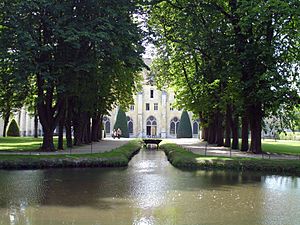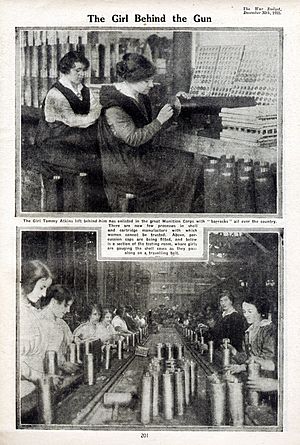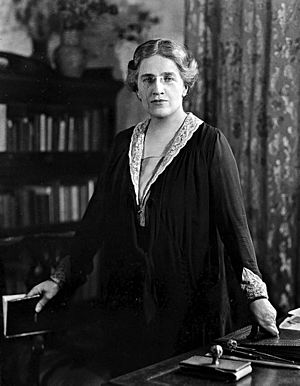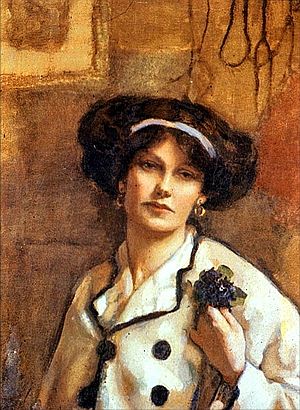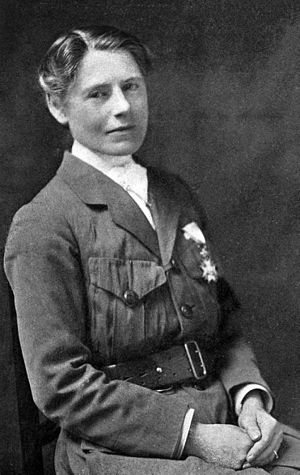Scottish Women's Hospital at Royaumont facts for kids
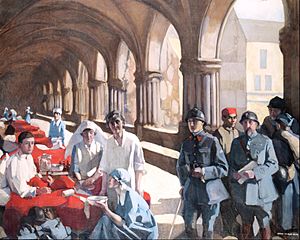
The Scottish Women's Hospital at Royaumont was a special medical hospital during World War I. It was open from January 1915 to March 1919. This hospital was run by the Scottish Women's Hospitals (SWH) group. It worked under the guidance of the French Red Cross. The hospital was located at Royaumont Abbey, a very old building near Asnières-sur-Oise in France. This spot is about 30 kilometers north of Paris.
The hospital was started by Dr Frances Ivens and Dr Elsie Maud Inglis. Dr Inglis was also the founder of the SWH. The hospital was well-known for helping soldiers injured in the Battle of the Somme. It was officially called Hôpital Auxiliaire 301. It was never connected to the British military or the British Red Cross. Most of the soldiers treated here were French. Some were also from French colonies in Africa.
This hospital was unique because it was run entirely by women. While other women's hospital units existed in France, the SWH was the largest group. They had hospitals in other countries too, like Serbia and Greece. Royaumont was the biggest British volunteer hospital. It was also one of the closest hospitals to the front lines. It was the only one that stayed open the whole time, from 1915 to 1919.
Contents
How It All Started
The Scottish Women's Hospitals first offered two hospital units. Each unit could hold 100 beds. These units were meant to be fully staffed by women. They even had some money from a women's rights group. However, the UK War Office and the British Red Cross said no to their offer.
So, the women turned to the French and Belgian Red Cross instead. A French noblewoman, the Vicomtesse de la Panouse, helped them. She suggested Royaumont Abbey as a possible location. The Abbey belonged to Édouard Goüin, a wealthy businessman. He was too unwell to fight in the war. So, he offered his property to help the war effort.
The Abbey was not ready to be a hospital at first. But Dr. Ivens loved the location. She wrote in 1917 that it was "an ideal spot." Even though they could hear the guns, its beauty helped wounded soldiers forget the war. Sometimes, when the wards were too full, patients were moved outside. Doctors noticed that patients recovered faster outdoors. So, they started letting patients stay outside more often. This gave them more sunlight.
Hospital Life and Challenges

Patients usually arrived from the Western Front. They came by train to a station in Creil, about 12 kilometers away. There was no way to send patients to other hospitals nearby. This meant the hospital sometimes had too many patients. During the Battle of the Somme, surgeons and doctors worked for eight days. They only got 16 hours of sleep in total!
The hospital had some tough conditions. It even failed its first inspection before opening on January 13, 1915. Electricity was often unreliable. If the power went out, surgeries had to be done by candlelight.
Amazing Medical Discoveries
Doctors at Royaumont did important research. They focused on treating a serious infection called gas gangrene. They found that using X-rays and checking for bacteria helped with diagnosis. They also found that removing infected tissue (called surgical debridement) and using special medicine (antiserum) worked well.
The doctors believed that different medical experts working together was key. This helped them fight infections and avoid too many amputations. The hospital even had a special mobile X-ray car. It was made by Austins and cost £300. Marie Curie, a famous scientist, helped set up the X-ray equipment. It had its own water and electricity. This X-ray car was very valuable. Other hospitals sometimes borrowed it. The British military even tried to take it for themselves!
Even with their great work, Dr. Ivens faced challenges. She had trouble publishing her research. In 1918, she needed permission from a French general to share her findings. She was not allowed to present her work directly to a medical society in Paris. Someone else had to present it for her.
Doctors at Royaumont made many important discoveries. But their work was not always recognized at the time. For example, Dr Agnes Savill showed in 1916 that X-rays could find gas gangrene early. This was before symptoms appeared or bacteria reports were ready. Her work was not widely accepted. Later, Dr. Ivens and Dr. Savill's work was reviewed in a medical journal. Dr E. J. Dalyell also published about a specific bacteria in gas gangrene in 1917. Sadly, later research on X-rays for gas gangrene often did not mention the work of these amazing women.
What They Left Behind
After the war, Dr Frances Ivens received a high honor from France. She was given membership in the Légion d'honneur.
Despite this, Dr Ivens could not get a job as a doctor in the British Army. By the end of the war, she did get a formal role in the French military. Six other Royaumont doctors also received a French military award. However, the hospital is not mentioned in the British official medical history of the war. No British medals were given to the staff.
Winston Churchill did praise their work in a letter. He said their work in Russia and Romania "will shine in history." He added that their achievements in France and Serbia were "no less valuable." He said no group of women had earned a higher reputation for their organizing skills and kindness.
Many of the doctors left general medical practice after the war. One exception was Dr Louisa Aldrich-Blake. She continued to work in women's health. The women who worked at Royaumont formed an association after the hospital closed in 1919. They even tried to open another unit at Royaumont when World War II began, but it didn't happen.
Who Worked at Royaumont?
Doctors
- Dr Louisa Aldrich-Blake - a surgeon
- Dr Agnes Forbes Blackadder Savill - a specialist in X-rays
- Dr Elizabeth Butler - a pathologist
- Dr Elizabeth Courtauld - an anaesthetist
- Dr Elsie Jean Dalyell
- Dr Lydia Manly Henry - a surgeon
- Dr Elsie Maud Inglis - the founder
- Dr Florence Elsie Inglis - Dr Elsie Maud Inglis's niece
- Dr Frances Ivens - the Chief Medical Officer
- Dr Helen Lillie - a surgeon
- Dr Louisa Martindale
- Dr Helen McDougall
- Dr Ruth Nicholson - an assistant surgeon
- Dr Gladys Miall-Smith
- Dr Winifred Margaret Ross - a surgeon
- Dr Marian Elizabeth Wilson - sadly died in July 1917
Other Staff Members
Many other people worked at the hospital, too. They included nurses, people who helped with general tasks (orderlies), ambulance drivers, cooks, and more. Here are some of them:
- Charlotte Almond - an orderly
- Millicent Sylvia Armstrong - an orderly
- Isobel Dorothy Banks - an ambulance driver
- Gertude Beckett - a nurse
- Frederick Butler - an ambulance driver
- Lucy Helen Carmichael - an orderly
- Marjorie Chapman - a nurse
- Elizabeth Colledge
- Vera Christina Chute Collum - an X-ray assistant
- Patricia Ramsay Crabb - a nurse
- Margaret Charlotte Davidson - an orderly, then a nurse
- Margaret Balfour Doig - a nurse
- Alma Dolling - an orderly
- Ruby Jamieson Donaldson - an orderly
- Chloris Sarah Drabble - a nurse
- Ariadne Mavis Dunderdale - a nurse
- Margaret Fairle - an orderly
- Catherine Maggie Findlay - a cook
- Isabel Kelman Flett - a nurse
- Elizabeth Forbes - an orderly and storekeeper
- Madame Fox - a seamstress
- Elizabeth Gilmour Manuel Arthur - an orderly
- Mary Gray - a nurse (died at Royaumont in January 1916)
- Margaret Gray
- Norah Neilson Gray - a nurse and artist
- Edith Catherine Hacon - an orderly, housekeeper, and seamstress
- Cecily Hamilton - a nurse and clerk
- Katherine Harley - an administrator
- Evelina Haverfield
- Etta Helen Maude Inglis - an orderly and nurse (niece of Elsie Maud Inglis)
- Violet Inglis - an orderly (niece of Elsie Maud Inglis)
- Mabel Effie Jeffery - a nurse
- Anna George Kreil - an orderly
- Isa Andrews Larnoch - a nurse
- Mary Crockatt Leuchars - an orderly
- Jean Marjorie Lindsay - an orderly
- Dorothy Littlejohn - a cook
- Jessie MacPherson - a cook
- Elizabeth Forbes MacPherson - an orderly and storekeeper
- Jean Forbes MacPherson - a cook
- Agnes Williamina Manson - an orderly
- Eveline Christiana Martin - a clerk
- Eunice Jean McGregor - an ambulance driver
- Florence Cecilia Moffat - an orderly and physiotherapist
- Alison May Nicholson - an orderly (sister of Ruth Nicholson)
- Margaret Nicolson - a nurse
- Catherine Bride O'Rorke - a nurse (received a French award)
- Winifred Parry - a nurse
- M. A. Prys-Owen - a nurse
- Norah Quihampton - a nurse
- Ishobel Ross
- Ruth Scott - an orderly
- Madge Ramsay Smith - a secretary and administrator
- Marjorie Starr - an orderly
- Nettie Stein - an orderly
- Jean Thom - a nurse
- Mary Moir Trail - an orderly
- Maude Evelyn Waddle - an orderly
- Beatrice Victoria Warr - a nurse
- Dulcie Mary White - a nurse
- Irene Mildred Whittet - a nurse
- Theodora Williamson - an orderly
- Maud Winstanly - a nurse and matron
- Florence Stanley Winter - a nurse
More Information
You can see a group photo of the Royaumont staff here: group photograph of Royaumont staff.




